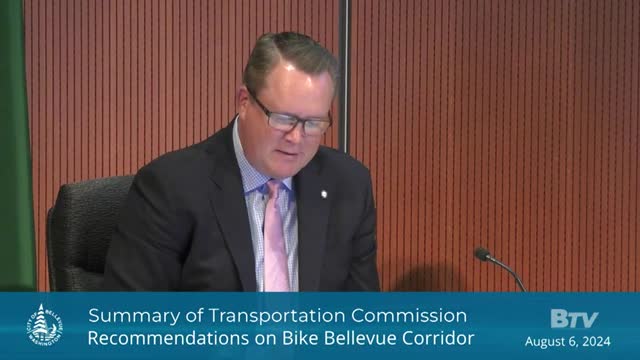City Council Rejects Controversial Bike Lane Proposal
August 06, 2024 | Bellevue, King County, Washington
This article was created by AI summarizing key points discussed. AI makes mistakes, so for full details and context, please refer to the video of the full meeting. Please report any errors so we can fix them. Report an error »

During a recent government meeting, significant discussions centered around the development of bike infrastructure in the city, particularly focusing on the contentious Bell Red Road corridor. Council members expressed a shared commitment to enhancing bicycle and pedestrian mobility, acknowledging the importance of community input in shaping these initiatives.
One council member emphasized the need for clarity in communication regarding transportation recommendations, suggesting that future agendas should explicitly highlight controversial topics to ensure public awareness and engagement. This point was underscored by the recent decision of the Transportation Commission, which opted not to pursue staff recommendations for bike lanes on Bell Red Road. The commission's vote was influenced by concerns over traffic congestion, as Bell Red serves as a crucial arterial road connecting various neighborhoods.
Data from transportation consultants indicated that reducing lanes on Bell Red would exacerbate existing traffic issues, potentially lowering vehicle speeds significantly during peak hours. The council member pointed out that maintaining vehicle capacity on Bell Red is essential for accommodating anticipated growth in the area, particularly with developments in Wilburton and the Spring District.
In lieu of bike lanes on Bell Red, the council member advocated for investing in alternative routes, such as the Spring Boulevard, which promises to provide safe and efficient connections without compromising vehicle traffic. This approach aims to enhance safety for all road users while addressing the community's needs for both cycling infrastructure and vehicular access.
The meeting highlighted the ongoing dialogue between city officials and residents, reflecting a commitment to balancing diverse transportation needs while prioritizing safety and accessibility.
One council member emphasized the need for clarity in communication regarding transportation recommendations, suggesting that future agendas should explicitly highlight controversial topics to ensure public awareness and engagement. This point was underscored by the recent decision of the Transportation Commission, which opted not to pursue staff recommendations for bike lanes on Bell Red Road. The commission's vote was influenced by concerns over traffic congestion, as Bell Red serves as a crucial arterial road connecting various neighborhoods.
Data from transportation consultants indicated that reducing lanes on Bell Red would exacerbate existing traffic issues, potentially lowering vehicle speeds significantly during peak hours. The council member pointed out that maintaining vehicle capacity on Bell Red is essential for accommodating anticipated growth in the area, particularly with developments in Wilburton and the Spring District.
In lieu of bike lanes on Bell Red, the council member advocated for investing in alternative routes, such as the Spring Boulevard, which promises to provide safe and efficient connections without compromising vehicle traffic. This approach aims to enhance safety for all road users while addressing the community's needs for both cycling infrastructure and vehicular access.
The meeting highlighted the ongoing dialogue between city officials and residents, reflecting a commitment to balancing diverse transportation needs while prioritizing safety and accessibility.
View full meeting
This article is based on a recent meeting—watch the full video and explore the complete transcript for deeper insights into the discussion.
View full meeting
